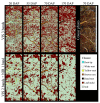Plant roots and spectroscopic methods - analyzing species, biomass and vitality
- PMID: 24130565
- PMCID: PMC3793172
- DOI: 10.3389/fpls.2013.00393
Plant roots and spectroscopic methods - analyzing species, biomass and vitality
Abstract
In order to understand plant functioning, plant community composition, and terrestrial biogeochemistry, it is decisive to study standing root biomass, (fine) root dynamics, and interactions belowground. While most plant taxa can be identified by visual criteria aboveground, roots show less distinctive features. Furthermore, root systems of neighboring plants are rarely spatially segregated; thus, most soil horizons and samples hold roots of more than one species necessitating root sorting according to taxa. In the last decades, various approaches, ranging from anatomical and morphological analyses to differences in chemical composition and DNA sequencing were applied to discern species' identity and biomass belowground. Among those methods, a variety of spectroscopic methods was used to detect differences in the chemical composition of roots. In this review, spectroscopic methods used to study root systems of herbaceous and woody species in excised samples or in situ will be discussed. In detail, techniques will be reviewed according to their usability to discern root taxa, to determine root vitality, and to quantify root biomass non-destructively or in soil cores holding mixtures of plant roots. In addition, spectroscopic methods which may be able to play an increasing role in future studies on root biomass and related traits are highlighted.
Keywords: IR spectrometry; electrochemical impedance spectroscopy; fine root; root biomass; root taxa; root vitality.
Figures




Similar articles
-
Evergreenness influences fine root growth more than tree diversity in a common garden experiment.Oecologia. 2019 Apr;189(4):1027-1039. doi: 10.1007/s00442-019-04373-5. Epub 2019 Mar 9. Oecologia. 2019. PMID: 30850886
-
Belowground plant parts are crucial for comprehensively estimating total plant richness in herbaceous and woody habitats.Ecology. 2019 Feb;100(2):e02575. doi: 10.1002/ecy.2575. Epub 2019 Jan 14. Ecology. 2019. PMID: 30516275
-
The unseen iceberg: plant roots in arctic tundra.New Phytol. 2015 Jan;205(1):34-58. doi: 10.1111/nph.13003. Epub 2014 Sep 10. New Phytol. 2015. PMID: 25209220 Review.
-
Distinct fine-root responses to precipitation changes in herbaceous and woody plants: a meta-analysis.New Phytol. 2020 Feb;225(4):1491-1499. doi: 10.1111/nph.16266. Epub 2019 Nov 19. New Phytol. 2020. PMID: 31610024
-
[Response of fine roots to soil nutrient spatial heterogeneity].Ying Yong Sheng Tai Xue Bao. 2004 Jun;15(6):1063-8. Ying Yong Sheng Tai Xue Bao. 2004. PMID: 15362636 Review. Chinese.
Cited by
-
Differential Responses of Wheat (Triticum aestivum L.) and Cotton (Gossypium hirsutum L.) to Nitrogen Deficiency in the Root Morpho-Physiological Characteristics and Potential MicroRNA-Mediated Mechanisms.Front Plant Sci. 2022 Jun 30;13:928229. doi: 10.3389/fpls.2022.928229. eCollection 2022. Front Plant Sci. 2022. PMID: 35845660 Free PMC article.
-
Quantification of Plant Root Species Composition in Peatlands Using FTIR Spectroscopy.Front Plant Sci. 2020 May 19;11:597. doi: 10.3389/fpls.2020.00597. eCollection 2020. Front Plant Sci. 2020. PMID: 32508861 Free PMC article.
-
Influence of sample preparation methods on FTIR spectra for taxonomic identification of tropical trees in the Atlantic forest.Heliyon. 2024 Feb 27;10(5):e27232. doi: 10.1016/j.heliyon.2024.e27232. eCollection 2024 Mar 15. Heliyon. 2024. PMID: 38455590 Free PMC article.
-
A starting guide to root ecology: strengthening ecological concepts and standardising root classification, sampling, processing and trait measurements.New Phytol. 2021 Nov;232(3):973-1122. doi: 10.1111/nph.17572. New Phytol. 2021. PMID: 34608637 Free PMC article. Review.
-
Raman spectroscopy as a tool for ecology and evolution.J R Soc Interface. 2017 Jun;14(131):20170174. doi: 10.1098/rsif.2017.0174. J R Soc Interface. 2017. PMID: 28592661 Free PMC article. Review.
References
-
- Agelet L. E., Ellis D. D., Duvick S., Goggi A. J. S., Hurburgh C. R., Gardner C. A. (2012). Feasibility of near infrared spectroscopy for analyzing corn kernel damage and viability of soybean and corn kernels. J. Cereal Sci. 55 160–165 10.1016/j.jcs.2011.11.002 - DOI
-
- Agrahari A. K., Meher A., Pradhan A. R. (2010). Energy dispersive X-ray spectroscopy (EDX) analysis of Curculigo orchioides Gaertn root tubers. Drug Invent. Today 2 29–30
-
- Allison G. G. (2011). “Application of Fourier transform mid-infrared spectroscopy (FTIR) for research into biomass feed-stocks,” in Fourier Transforms – New Analytical Approaches and FTIR Strategies ed. Nikolic G. (Rijeka: InTech; ) 71–88
-
- Barsoukov E., Macdonald J. R. (2005). Impedance Spectroscopy: Theory, Experiment, and Applications. Hoboken, NJ: John Wiley & Sons; 10.1002/0471716243 - DOI
LinkOut - more resources
Full Text Sources
Other Literature Sources

